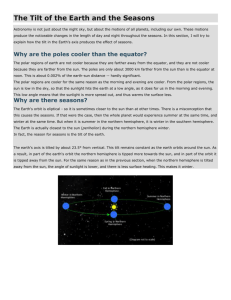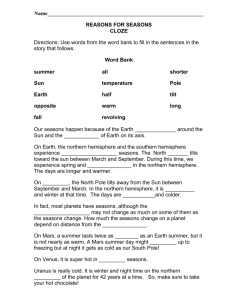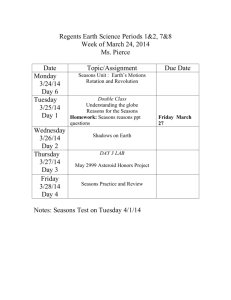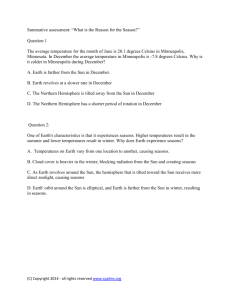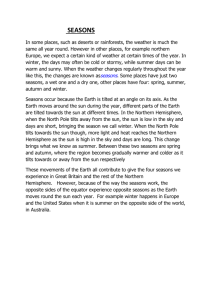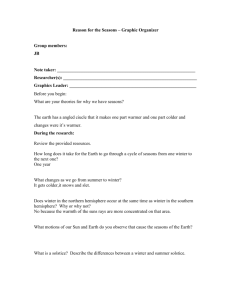Part 1 - Ball State University
advertisement
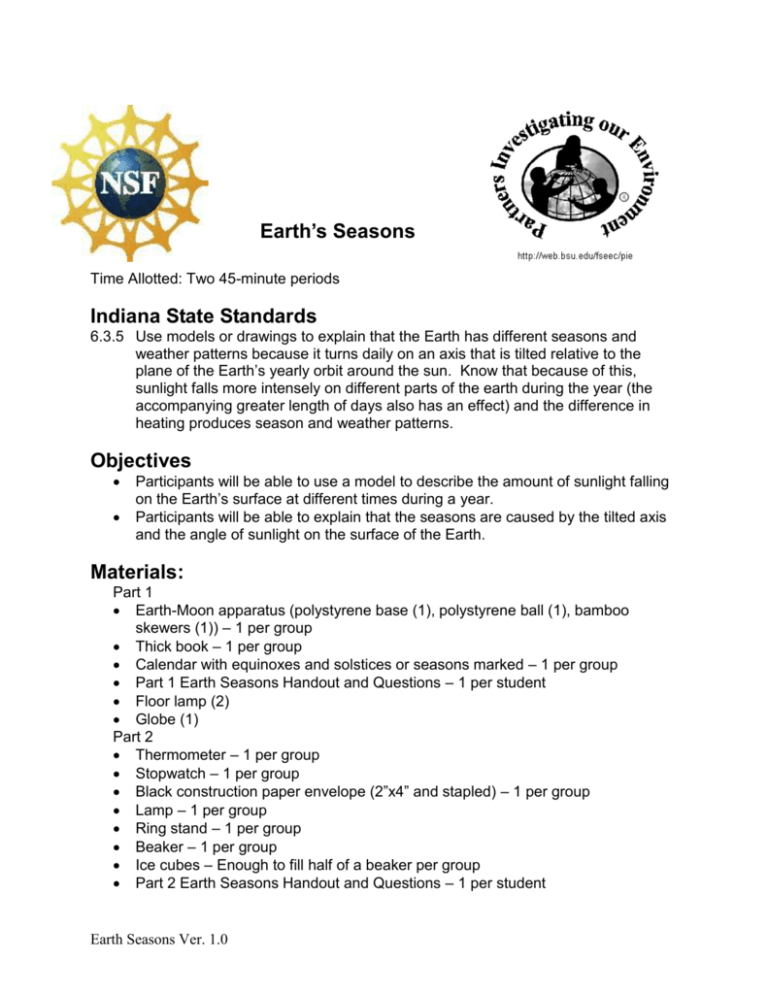
Earth’s Seasons Time Allotted: Two 45-minute periods Indiana State Standards 6.3.5 Use models or drawings to explain that the Earth has different seasons and weather patterns because it turns daily on an axis that is tilted relative to the plane of the Earth’s yearly orbit around the sun. Know that because of this, sunlight falls more intensely on different parts of the earth during the year (the accompanying greater length of days also has an effect) and the difference in heating produces season and weather patterns. Objectives Participants will be able to use a model to describe the amount of sunlight falling on the Earth’s surface at different times during a year. Participants will be able to explain that the seasons are caused by the tilted axis and the angle of sunlight on the surface of the Earth. Materials: Part 1 Earth-Moon apparatus (polystyrene base (1), polystyrene ball (1), bamboo skewers (1)) – 1 per group Thick book – 1 per group Calendar with equinoxes and solstices or seasons marked – 1 per group Part 1 Earth Seasons Handout and Questions – 1 per student Floor lamp (2) Globe (1) Part 2 Thermometer – 1 per group Stopwatch – 1 per group Black construction paper envelope (2”x4” and stapled) – 1 per group Lamp – 1 per group Ring stand – 1 per group Beaker – 1 per group Ice cubes – Enough to fill half of a beaker per group Part 2 Earth Seasons Handout and Questions – 1 per student Earth Seasons Ver. 1.0 Background: This lesson has two parts that help to explain the different seasons experienced throughout the year. The causes of the climates of different areas are not intuitive. A common misconception is that the Earth is closer to the Sun in the summer and further away in the winter. In actuality this is untrue, for the northern hemisphere the Earth is 147.5 million km away from the Sun in summer and 152.6 million km away in winter (Phillips, 2005). These distances are so great that it is not actually the heat of the Sun affecting the Earth. Another misconception of those living in the northern hemisphere is that temperatures get colder as one travels north, but for those at the equator if you traveling south the same happens. Unlike cold temperatures at higher altitudes (mountains), cold temperatures at higher latitudes are not easily explained. The cold temperatures are caused by the angle in which the sunlight hits the surface of the earth. At the equator the sun is overhead and light directly impacts the surface making it hot. At the poles the angle of the sunlight is almost parallel with the surface. This indirect light causes the higher latitudes to remain cold and not heat up. This is only part of the reason that the Earth experiences a different seasons. The seasons of the Earth are also controlled by the more direct sunlight received in a hemisphere during the yearly orbit due to the tilt of the Earth’s axis. The axis of the Earth is tilted at about 23.5º and it constantly points in the same direction, the North Pole towards Polaris (the North Star). It is easier to think of the Earth as a spinning top on the floor of a room (WU, 2000). Imagine that in the center of the room is the Sun and the top circles around it, or orbits. As the top circles the room it remains tipped toward one of the same wall at all times. This means that some times the top’s bottom is more exposed to the Sun during part of orbit and the top’s top is more exposed at the other side of the orbit (WU, 2000). Like the top, when the northern hemisphere is tipped toward the Sun, the sunlight is more direct causing the summer season. Meanwhile, as the northern hemisphere is pointing towards the Sun, the southern hemisphere has less light and experiencing the winter season. The two hemispheres experience the opposite season throughout the year because of tilt of the Earth. If the Earth did not have a tilted axis, seasons would not exist. The angle of light would be constant and so would the climate. The equator would be hot, the poles cold, and the middle latitudes would some where in the middle never changing and never changing seasons. Please see the following websites for more information and diagrams. The following websites are a good review/overview of the Earth’s seasons: http://www.rcn27.dial.pipex.com/cloudsrus/seasons.html http://www.windows.ucar.edu/tour/link=/kids_space/why_seasons.html&edu=high The following websites have good information, but are of a more technical nature: http://library.thinkquest.org/29033/begin/earthsunmoon.htm http://www.ecology.com/ecology-today/tilting-earth/ http://science.nasa.gov/headlines/y2000/ast30jun_1m.htm Earth Seasons Ver. 1.0 Procedure Engage: (10 min) This engagement activity relies upon the students conveying their personal experiences of the different areas they have traveled and the previous knowledge students have of the climates around the Earth. There are two parts to this lesson, but each activity requires a similar engagement if both are not done. To start the discussion, have students divide into groups with one student acting as the recorder. Have students list all the other states and countries they have visited. Also on the list have the recorder put the time of visit (ex. month or season) and the weather/temperature. o If students have not been out of state, have them assemble a list of places they have heard about and the weather/temperature they would expect there during different times of the year. o Try to steer students away from hot, cold, warm references and have them use references in relation to the city they currently live. (Ex. South Carolina in July was hotter than Indianapolis in July) This will allow for easier comparison between different sites. Have each group give their locations that are furthest north and south and write them on the board with the weather/temperature descriptions. o Ask if the students see a trend in the data? o If no trend is present, ask the following: What happens as you go south or north? Students should respond that near the equator is hot and that near the North Pole is cold. o A generalized response should be “If you go north it gets cold, if you go south it gets warm.” After getting something similar to the generalized response above have students explain the following: o Why are northern areas colder? o Why is Antarctica cold if the generalized statement is true? o Are the seasons for North America the same for South America or Australia? What causes the difference? o What causes the seasons? Start to discuss the differences in timing for the seasons in the Northern and Southern Hemispheres. That winter for the Northern Hemisphere is the summer for the Southern. Also introduce that the Earth’s axis is tilted about 23.5º and the top always points in one direction. Assemble the Earth-Moon apparatus and demonstrate its use to the students. Review the concepts of one rotation equaling a day, one revolution around the sun equaling a year, sunrise, sunset, daytime, nighttime. Also use a standard globe to compare it to the Earth-Moon apparatus Part 1: Explore: Setup for this part consists of the following: Earth Seasons Ver. 1.0 1. Setup the room like the figure 1. This allows for eight groups of students to work on the Part 1 activity at the same time. 2. Make the desks near the front of the room position 1 and label the others as in the figure 3. Activity: Desk 1 1 1. Assign students to groups at the different positions and pass out the Earth-Moon 2 4 2 4 apparatus (Figure 2) materials and the Part 1 Lamp 3 3 Handout and Questions. 2. Instruct the students on the assembly of the Earth-Moon Figure 1: Room Setup for Part 1 apparatus. The final result should resemble Figure 2. Help the students draw the equator, North Pole (N), South Pole (S), and a rough dot at the latitude they live as a reference point. Have the students tip the apparatus toward the front of the room with the help of a thick book. 3. Turn on the lamps and have students record the side of the Earth lit up by the “Sun” (lamp) for each station on the Part 1 handout as the students circulate the stations in a counter clockwise direction with their Earth-Moon apparatus. Front of Room Explain: 1. In the groups have students assign each position a season for the northern hemisphere and the calendar date BOOK associated with each. After they decide have the groups present the assigned seasons for the four positions. Use this Figure 2: Earth-Moon Apparatus time to discuss the positions and give the students the correct answers to the positions. The seasons match to the following positions: 1-Winter, 2-Fall, 3-Summer, and 4-Spring. 2. In the discussion have the students answer the following for the northern hemisphere: a. Why is winter cooler than summer? i. Answer thus far: (During winter the northern hemisphere is exposed to less light than the southern causing winter.) b. What causes the seasons? i. Answer thus far: (The tilt of the Earth causes more light to fall on different parts of the Earth causing the seasons.) 3. After the students have recorded all four stations, have them answer the questions for Part 1. Students may require help answering the questions and this part could be more of a group discussion. Answers to the questions are at the end of this packet. Earth Seasons Ver. 1.0 Part 2: For this part of the lesson students need to be familiar with reading the thermometers that will be used. If necessary review the procedure and units the thermometers measure. To set up for Part 2 cut and assemble square black envelopes out of black cardstock and staples, enough for each group. Explore: Hand out the Part 2 worksheet, questions, thermometers, black envelopes, stopwatches, ring stands, beakers, ice, and lamps to each group of students. It is important when getting started that you help students make the conceptual leap that they are simulating the sun and the surface of the Earth. To make it easier set up a lamp and globe and put a thermometer on the surface. Move the thermometer over the surface of the globe to show the different angles as the thermometer moves from the equator to the poles. Also, use the Earth-Moon apparatus to demonstrate the different angles the thermometer and lamp make for the different seasons. Instruct the students in the set up of the equipment or have it done prior to beginning. Have the students follow the directions and the diagrams on the Part 2 worksheet and record their data on the provided Temperature Data Table. To save time different groups can run different trials and then share data. After the data is collected have the students graph the three different trials to compare the temperature increases. Explain: Have the groups present the results of the three trials. Have the students identify which trials correspond to the different places on the Earth. Identify that the trial that heated up the fastest was caused by the direct light on the flat envelope. Have the students answer the questions for Part 2. These questions can be used in the discussion to relate the Part 2 activity with the seasons. Elaborate: Discuss the two factors that cause the seasons. Have the students figure in the amount of light in a day and the seasons. In this discussion have the students figure out the reason the North Pole does not get hot even though it gets 24 hours of light in the summer. If needed set up the Earth-Moon apparatus again and demonstrate the 24 hours of light. Students should identify that the tilt of the axis and the angle of the sunlight at different times of the year causes the seasons for the Earth. References: Philips, T., 2005, http://science.nasa.gov/headlines/y2000/ast30jun_1m.htm Windows to the Universe (WU), 2000, http://www.windows.ucar.edu/tour/link=/kids_space/why_seasons.html&edu=high Earth Seasons Ver. 1.0 Questions and Answers: Part 1 1. When did the Northern Hemisphere receive the most light? What was the Southern Hemisphere like at this time? Position 3, Southern Hemisphere had very little light 2. When did the Southern Hemisphere receive the most light? What was the Northern Hemisphere like at this time? Position 1, Northern Hemisphere had very little light 3. Are there times when both northern and southern hemispheres receive the same amount of light? When do these occur? Yes, Position 2 and 4 4. When does the equator receive the most light? All positions 5. Do you think that there is a relationship to the amount of light received and the temperature? Yes (This should be the answer prior to completion of Part 2) 6. Do you think that there is a relationship between the amount of sunlight and the season? Given your answer, which positions correspond to which seasons? (Again this answer is answered before Part 2, have students answer for the Northern Hemisphere) Yes; Position 1 = Winter, Position 2 = Spring, Position 3 = Summer, Position 4 = Fall 7. How much light does the North Pole get in the summer? Why is the North Pole not hotter than the equator? 24 hours. Any answer that tries to explain the second part of this question should be accepted. Without completing Part 2 the correct answer is not known. If you would like hold this question until Part 2 is complete. 8. What is causing the seasons? Thus far the answer should be: The Tilt of the Earth.1 Part 2 1. Which trial showed the greatest temperature increase? Flat Trial 2. What causes the differences in the temperature increases between the trials? Angle of light 3. Which trial best represents the way sunlight strikes the equator? Flat Trial 4. Which trial best represents the way sunlight strikes the poles? Standing Trial 5. What parts of the globe would the remaining trial represent? Mid-latitudes OR half way between equator and the poles 6. Why is the equator always hotter than the poles? Angle of sunlight is more direct, unlike the poles, which are more indirect sunlight. 7. Why is the northern hemisphere hotter in July? More direct sunlight and more sunlight 8. Why is the southern hemisphere colder in July? Less direct sunlight and less sunlight 9. What two things cause the Earth to have seasons? (Hint: Look at Part 1 and Part 2 of the Earth Seasons handouts.) Angle of sunlight and tilt of the Earth’s axis Earth Seasons Ver. 1.0

